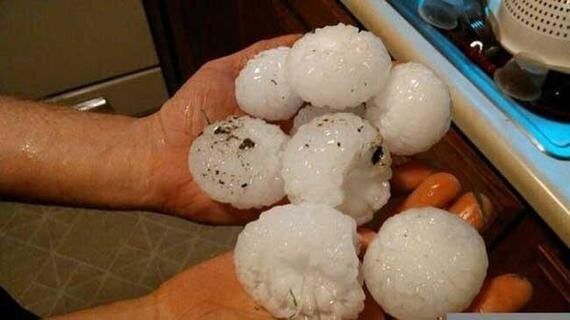1.It might seem strange for balls of ice to fall from the sky during summer but that's actually when hail is most common as there is more energy available at warmer times of year and this translates into bigger clouds.
2.Within the biggest cloud of them all - cumulonimbus - there are strong updraughts of air that lift water droplets high into the colder part of the cloud where they become supercooled water and freeze on contact with condensation nuclei.
These ice crystals will fall and then rise again, each time adding a new coating of ice before eventually becoming too heavy for the updraught and the hailstones fall to the ground.
3.In order for hail to form the temperature of the top of the cumulonimbus cloud must be colder than -20C and a large proportion of the cloud will be below freezing. Severe thunderstorms will produce larger hailstones.
4.Hailstones typically measure between 5 and 200mm in diameter, with their size usually compared to objects such as peas, golf balls or grapefruit. They can weigh up to 1kg, and if the hailstone collide and stick together can even be as heavy as 4kg.
5.Hailstones fall so quickly they often don't get time to melt before hitting the ground, even in the warm summer months.
A hailstone the size of a baseball (about 75mm) weighs about 150g and can fall at speeds of 100mph. This can cause a lot of damage, with entire crops being wiped out in just a few minutes during a large hailstorm.

6.When you cut a hailstone in half, you can see rings of ice. Some rings are milky white while others are clear. Counting the layers gives an indication of how many times the hailstone travelled to the top of the storm cloud.
It's thought the clear layers form when the hailstone is in a part of the cloud where the air temperature is just below freezing so the water slowly freezes over the hailstone and air bubbles can escape.
The milky white or opaque layers of ice form when the air temperature is well below freezing and a water droplet freezes immediately upon colliding with the hailstone, trapping the air bubbles.
7.During the winter months in the UK the hail we get is actually called graupel. This soft hail is different to proper hailstones as it tends to form when supercooled water droplets add a layer of ice or rime to falling snowflakes.
So graupel can fall from the same clouds that produce snow, such as nimbostratus and stratus, and not just cumulonimbus.
8.The largest hailstone in the UK fell in Horsham, West Sussex, on 5 September 1958 and weighed 142g.
9.Rather more impressive is the largest recorded hailstone in the US which fell in Vivian, South Dakota on 23 July 2010. It weighed 0.88kg and was 20cm in diameter.
10.As well as causing damage to properties and crops, hailstones can be fatal. Close to 250 people in India were killed by falling hail in 1888.